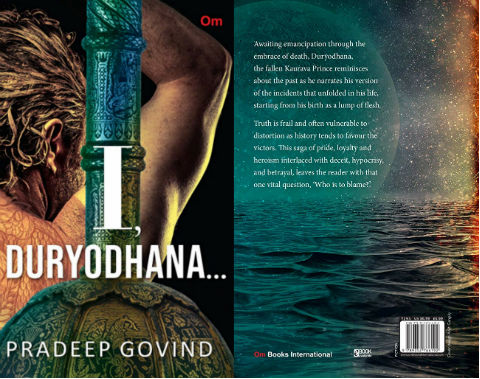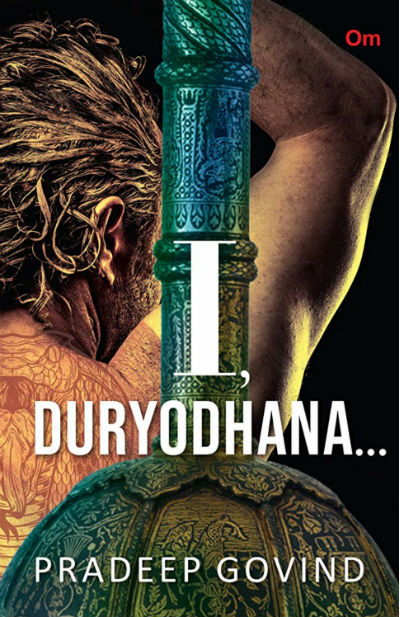This Is Here In For You
Listen To The Podcast:
If you love to listen to the book review over reading, or if you want to go through it while doing other activity, here is our Podcast of this review article. Do listen, and share your thoughts with us.
Spotify:
YouTube:
Mahabharata is famously known to contain every possible story that human minds can conjure and all shades of grey in the characters that play a part in its rich and complex narrative. And so it happens that the stories from Mahabharata have been interpreted and re-told by every generation as the world changes and yet remains the same for its inhabitants.
While Vedvyasa’s Mahabharata can be perceived to portray Duryodhana as a villain, the attempts to feature his story from a different perspective also go back thousands of years. The first such re-telling that comes to mind is Bhasa’s “Urubhangam”. This brilliant play by one of the most beloved Sanskrit writers showed Duryodhana as a human being, making mistakes, repenting and displaying heroic qualities as he went through the last fight of his life and the hours before his death.
These were the first thoughts in my mind when Om Books International provided us a copy of Pradeep Govind‘s book I, Duryodhana for unbiased reviews by Team Thinkerviews.
| Book Title | : | I, Duryodhana… |
| Author | : | Pradeep Govind |
| Publisher | : | Om Books International (30 April 2019) |
| # of Pages | : |
344 (Paperback) (506 KB) 270 (Kindle EBook) |
| # of Chapters | : | – |
| Purchase Link(s) | : |
The trend in Indian fiction to tell historical / mythological stories from a modern point of view has been developing over last few years, and there are a number of many books that have come across as stories of the defeated sides; e.g.
And there are a lot more out there, so how’s I, Duryodhana?
As there are numerous books in the stores featuring Indian mythological characters, the name alone is not enough to distinguish the book from its contemporaries. It is very important to have an attractive coverpage. So, let’s take a look:

I, Duryodhana by Pradeep Govind – Book Cover
The front cover shows the backside of the head and tattooed torso of a warrior holding his legendary gada (the mace), while the back cover features the book blurb on a background of icy, blue waters – presumably of the lake wherein Duryodhana sought shelter before the last and final battle with Bheema. The colour scheme is attractive and the book covers have the modernistic, sleek feel to it. I think it will do a good job of attracting browsers.
We meet the Prince of Kauravas on the last day of his life, as he is reminiscing about the war he has just left behind and everything that led to the war. The first few pages take you straight into the psyche of Duryodhana as we go through his life from his point of view in the following chapters.
The storyline follows very closely to the events described in Vyasa‘s Mahabharata. From the birth of unformed, premature lump from Gandhari as she beat her womb in frustration to Vyasa’s intervention that led to creation of the hundred Kaurava princes and their sister Dushala, Duryodhana tells us about how he started the journey of life and the inauspicious omens at the time of his birth proclaiming death and destruction. We travel through Duryodhana’s life as his uncle Shakuni becomes his “parent-in-charge” at a young age and his life irrevocably changes when his five cousins arrive at Hastinapur with their mother Kunti.
The usual spats of childhood follow as Pandavas and Kauravas grow up and finally split in front of the public at the time of their final exams as Karna walks in and becomes Duryodhana’s life-long friend. The Pandavas perish in the Lakshagrih and Duryodhana’s path is clear to become the King of Hastinapur. But, the Pandavas return and marry Draupadi. The kingdom of Hastinapur is divided and the new empire is created by Pandavas with their capital of Indraprastha. The seeds of jealously, envy and sense of injustice sown in childhood finally sprout to the poisonous events of Dhyutsabha.
Pandava’s exile of thirteen years follow. In Duryodhana’s mind they have absolutely no right to being kings in Aryavarta and so the cousins face each other in the final battle of their lives – where their destinies have been leading them for their whole life.
There are, however, really no winners in a war, are there?
The author makes it very clear at the beginning of the book that it is a work of perception. This is very true here as Mr. Govind does not introduce invented players or change the course of events to glorify Duryodhana’s character. His narrative more or less follows the same course as the well-known versions of Mahabharata. The main difference, however, is the narrator, as it is the story told by Duryodhana in the first person. So we see the world as he sees it through the prism of his opinions. We see his cousins through his eyes whom he always refers to as Kaunteyas rather than Pandavas – a small but significant difference as it strengthens Duryodhana’s belief why they are not the rightful heirs to his Hastinapur.

I, Duryodhana by Pradeep Govind – Book Cover
All siblings and cousins have arguments and fights as they grow up. And in childhood, they are still learning the difference between right and wrong. So it is easy to see how Duryodhana’s views of his cousins are strongly coloured by the influence of his uncle Shakuni, who has taken over the role of his parents. Duryodhana’s natural protectiveness for his own brothers including Dushasana is also very clearly visible. Unfortunately, these small quarrels of childhood lead to deep-rooted prejudices on both sides – Pandavas and Kauravas, and things get worse as they grow up. The author tries to highlight these aspects of the tale as we go through the first phase of the book.
The Mahabharata has many unconventional aspects, and the life of the Pandavas did not follow the normal path – they were different right from their birth to their marriage to everything else they did in their lives. As far as Duryodhana was concerned, nothing they did was right according to the customs of their world, whether it was marrying Draupadi or burning Khandavprastha:
Forest on river Yamuna was the dwelling place for innumerable species of animals, birds, reptiles, rodents, various other life forms and also the rarest of trees, plants, and herbs that served as the source for medicinal remedies for various ailments. The forest also provided the best of teak and willow, which had contributed to the trade and economy, not to mention their use in architecture that was the trademark of my Hastinapur. Local tribes depended on this forest for firewood, fruits, meat and other needs for their livelihood. The Kaunteyas completely overlooked the need for ecological preservation and ensured that no inhabitant of the forest escaped the conflagration.
Throughout the book, there are many places where Duryodhana points out the limitations of his cousins, especially Yudhishthira. The following para shows one such argument:
All these years, you have been successful in fooling your friends and allies by hiding your shameful dark self with this veil of righteousness but you don’t fool me with your hypocrisy. What man will even look with eyes of desire upon the wife of a younger brother, who should be seen as daughter? Yet using your mother’s words as an excuse you brothers shared the daughter of Drupada as a common wife just to avoid strife amongst yourselves. This shows how thin is the thread that holds you brothers together. Then, as if it was not enough, you pledged her too in game of dice. What my brother Dushasana did to Draupadi pales in comparison to what you have inflicted on her. You and your mighty brothers who brag so much of the capabilities of your arms and armaments sat as mute impotent spectators while your Queen was humiliated in public.
Similar observations follow as Duryodhana perceives slights and insults in everything the Pandavas do and keeps true to his stubborn belief in his right to the throne of Hastinapur until the very end.
The author also shares insights into human nature providing a different perspective on the characters like Eklavya and highlight Duryodhana’s quick judgmental nature through his early years:
Eklavya shooting seven darts into the mouth of that harmless mongrel just because he could and there would be no one to answer to…someone with that attitude…can you imagine what a menace to society he would become once he attained mastery in the science of battle? The highest dharma of a true warrior is to protect the weak and uphold justice. Power is something to be used for constructive and progressive purposes. It is not something to be abused.
Or as he meets Karna and strikes an instant friendship for life:
I firmly believed that the birth and death of a person was not half as important as that of the life that he led.
Hatred is a very powerful driver for what we do in life, and if there was no one to hate?
The sudden absence of the prime objects of my hatred from my life seemed to leave an unexplainable void.
The author displays Duryodhana’s knowledge and ability to think differently through various quotes like the ones below:
Truth is sacrosanct, but as we all know, it runs in layers and its perceptions may change with the uncovering of each layer.
Dharma is very subtle in nature. There is no such thing as ‘right’ or ‘wrong’. They are relative concepts wrapped in the foils of time and space.
But neither his good qualities nor his friendship with Karna, his relationship with his wife Bhanumati and his love for his children are able to thwart the inevitable war he chooses in the end. All throughout his life, he has almost fatalistically waited for it with no doubt about his own victory:
Are we all not pawns in the hands of destiny? If the all-knowing creator has something stored for us in our destiny, it cannot be prevented despite our best intentions and efforts.
If you believe in your cause, fight fair and fight without care for victory or defeat, for in that lies the pathway to your glory.
And so after seventeen days of death and destruction, when all moral codes have been broken and unimaginable acts have been committed, Duryodhana accepts his own end almost philosophically:
The only way that I can square up with all those heroes who died for me is by either winning this war or paying with my life.
The fate doesn’t approve of our intentions. The only way forward for us is to fight for glory without care for victory or defeat.
As you can see, Duryodhana is a complex character, and Mr. Pradeep Govind has made a sincere attempt at telling his life story from his angle. As he says in the beginning, most of the tales are told by the victors and so become the victor’s account. While this is true in most cases, I think the Mahabharata is slightly different. If anything, it is the story of futility of war, because even the victors have nothing left but ashes at the end of it. While we may admire Duryodhana for his valour, we cannot always agree to his interpretation of events in this book, for example, when he tries to justify the death of Abhimanyu:
It was one such act of unethical warfare that had sullied the fair name of Rama, the famous Prince of Ayodhya, when he killed Vali, the King of Kishkindha, who was engaged in a single combat with his brother Sugriva who had challenged him. This was different from Abhimanyu’s case, where there was no personal call for combat or challenge between anyone. That battle was more general with Abhimanyu going on a rampage like a wild elephant in a sugarcane field using Gandharva warfare, and we had no option but to collectively check him.
The battles of Mahabharata shows us how barbaric humans can become and how easy it is to lose the perspectives of right and wrong, truth and lies, Dharma and Adharma when you aim for victory at any cost, and this applies to both sides. Everyone made mistakes and paid for them dearly – whether it was the Pandavas or the Kauravas.
The best parts of the book are where the author describes Duryodhana’s thoughts – like the very beginning of the book or when he is near the end. The book is filled with many details on battle plans, ie., vyuhas, description of concepts like Samsaptaka vows, astras, rakshasa and Gandharva warfare, etc. that makes it an interesting read even though you may know the story.
Summary:
Because you know the story of Duryodhana and Mahabharata, this book allows you to explore characters and perspectives and form your opinions rather than focusing on “what happens next”, and that I think makes it a good read.
Around 7 out of 10.
Quick Purchase Links:
- Buy Book From Amazon India – Paperback
- Buy Book From Amazon India – Kindle EBook
- Buy Book From Amazon US – Paperback
- Buy Book From Amazon US – Kindle Ebook
Over To You:
If you already have read the book do share your remarks and thoughts via comments below. Does this review help you in making your decision to buy or read the book? Do not forget to share this article with your friends over various social networks via Twitter, Facebook and others. And yes, you may like to subscribe to our RSS feeds and follow us on various Social networks to get latest updates for the site to land right in your mail box.
 ThinkerViews – Views And Reviews Personal views and reviews for books, magazines, tv serials, movies, websites, technical stuff and more.
ThinkerViews – Views And Reviews Personal views and reviews for books, magazines, tv serials, movies, websites, technical stuff and more.




